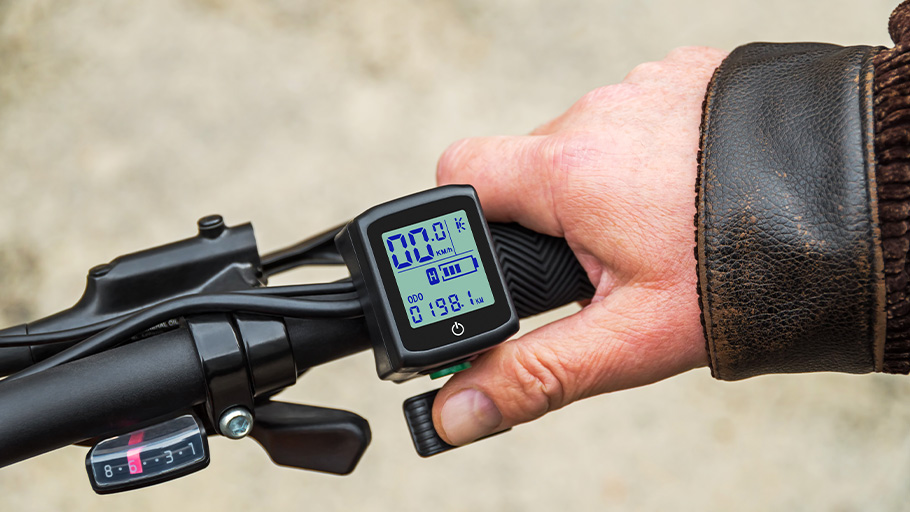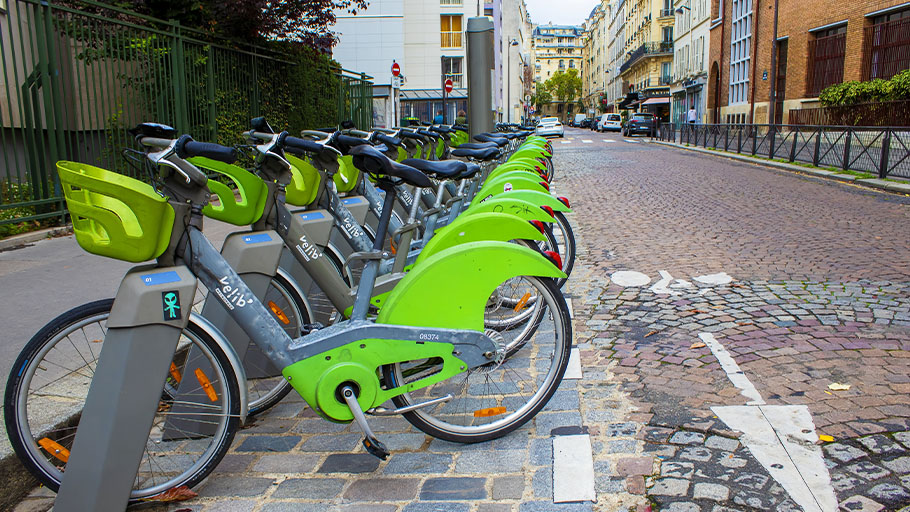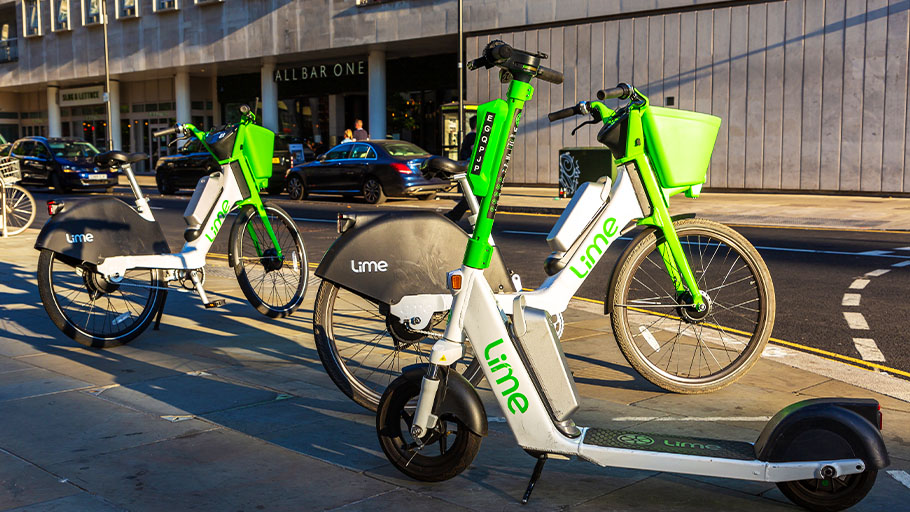
Electric bikes have emerged as a popular and sustainable mode of transportation, offering convenience, environmental benefits, and improved mobility. In this article, we delve into the history of electric bikes, look at their rise in popularity, and explore how and where they are commonly used. Additionally, we examine the unique requirements for e-bike parking, including installation space, charging infrastructure, security, and cost considerations.
The First Electric Bikes

While bicycles have been around for centuries, electric bikes, commonly referred to as e-bikes, have a relatively short history starting in the late 20th century when early prototypes began to emerge. These early models represented the initial forays into the world of electric-powered bicycles. While they showcased the potential of electric propulsion, they faced significant challenges such as weight and limited power output.
One notable example of an early electric bike is the GT Charger, which made its debut during this period. These early models suffered from cumbersome designs and relatively weak motors. The batteries available at the time were heavy and offered limited energy capacity, resulting in shorter ranges and less satisfactory performance. As a result, they struggled to gain widespread popularity and acceptance.
However, the 21st century marked a pivotal moment for e-bikes as technological advancements began to revolutionize the industry. Key breakthroughs, such as the development of affordable high-energy lithium-ion batteries and high-torque magnetic motors, brought about a significant transformation in the capabilities and appeal.
The introduction of lithium-ion batteries addressed the weight and energy capacity limitations that plagued earlier models. These batteries are lightweight, compact, and offered a considerably higher energy density, enabling electric bikes to achieve longer ranges and improved performance. With greater energy efficiency, users could enjoy extended rides without worrying about running out of power.
Simultaneously, advancements in motor technology played a crucial role in enhancing the power and torque output of electric bikes. High-torque magnetic motors, provided efficient and reliable propulsion systems. The combination of powerful motors and advanced battery technology propelled electric bikes into a new era of performance and usability.
Furthermore, the integration of intelligent motor control systems and electronic components enhanced the overall riding experience. Features such as pedal-assist systems, which provide varying levels of electric assistance based on rider input, made cycling more accessible to a broader range of individuals. This innovation allowed riders to customize their riding experience, adjusting the level of assistance to their preferences and desired exertion.
The advent of these technological advancements paved the way for the modern electric bikes we see today. These have become more streamlined, efficient, and aesthetically appealing. The market now offers a wide range of models, including commuter bikes, mountain bikes, folding bikes, and cargo bikes, catering to various needs and preferences.
A Rise in Popularity

In recent years, electric bikes have experienced a significant surge in popularity. Several key factors have propelled their widespread adoption, making them a preferred choice for many. The rising awareness of environmental issues and the urgent need to reduce carbon emissions have prompted individuals to seek sustainable alternatives to traditional transportation. Electric bikes, with their zero-emission electric motors, provide an eco-friendly option that aligns with the goals of the environmentally conscious.
These bicycles also offer compelling economic advantages. With fluctuating fuel prices and the rising costs of car ownership, individuals are exploring more economical modes of transportation. E-bikes provide a cost-efficient alternative, as they require minimal maintenance, eliminate the need for expensive fuels, and have lower operating costs compared to automobiles.
Beyond the environmental and cost considerations, electric bikes offer significant health benefits. In an era where sedentary lifestyles have become all too common, electric bikes encourage physical activity and exercise. They provide an ideal solution for individuals who may not have the fitness levels or physical capabilities to engage in strenuous cycling. With electric assistance, riders can choose the level of exercise that suits their needs, allowing them to incorporate physical activity into their daily routines without feeling overwhelmed. This combination of convenience and health benefits has resonated with individuals seeking a more active lifestyle.
Electric Bike Use
E-bikes serve a multitude of purposes and cater to diverse user needs. Commuters find electric bikes invaluable for navigating congested city streets, allowing them to bypass traffic jams and arrive at their destinations faster. The compact nature of electric bikes also facilitates easy maneuverability and parking in crowded urban areas, making them an ideal choice for urban transportation.
Enthusiasts and recreational riders appreciate the added thrill that electric bikes offer. The electric assistance provides an extra boost, enabling riders to conquer challenging terrains and enjoy longer rides. Electric mountain bikes in particular have gained popularity among outdoor enthusiasts, offering an exhilarating experience while still respecting the natural environment.
Electric bikes have also found a niche in the delivery industry. With the growing demand for efficient and eco-friendly logistics solutions, some businesses have embraced e-bikes as a practical and sustainable option. Delivery riders on electric bikes can navigate congested city centers swiftly, minimizing delivery times and reducing carbon emissions. The associated cost savings also make them an economically viable choice for businesses in the long run.
Electric Bike Parking

When it comes to parking solutions, there are a few key differences between electric bike parking and regular bike racks. One of the most obvious differences is the size and weight of the bikes. E- bikes tend to be larger and heavier than regular bikes, which means they require more space to park. For example, some electric bikes have wider tires than regular bikes, which may require wider bike racks or additional spacing between bikes.
Additionally, some facilities will choose to provide charging for e-bikes. Charging stations need to be located where the charging infrastructure can be connected to power and may require even more spacing between racks. There are a variety of parking solutions available on the market to suit a range of locations. Some racks are designed to fit one or two e-bikes into tight spaces but do not provide charging, while others may include multiple rows of full-featured racks that are best suited to large outdoor areas.
Another important consideration is the level of security required. Electric bikes are generally more expensive than regular bicycles, which makes them a more attractive target for theft. Therefore, electric bike parking facilities must provide a higher level of security, such as locking mechanisms that secure both the frame and front wheel, or advanced access control systems that use key cards or mobile apps to lock and unlock the bicycles. Bike lockers are one option that provide both the extra space and security for e-bikes.
Finally, cost is an important factor to consider when planning and installing e-bike parking. Due to the unique needs of electric bikes, electric bike parking solutions are generally more expensive than regular bike racks. Despite the higher cost, there are a few cost-effective electric bike parking solutions available on the market, with some companies offering a modular design that allows you to only pay for the features you need now. For example, some manufacturers offer charging stations as an add-on that can be easily installed later, which can help reduce the upfront cost.

Electric bikes are becoming increasingly popular as a sustainable and practical mode of transportation. Environmental consciousness, cost-effectiveness, health benefits, and the support of governments and organizations have all played pivotal roles in their success. From daily commuting to recreational riding and even commercial applications, electric bikes have proven to be a versatile and sustainable solution for urban mobility, fulfilling a variety of purposes and catering to the needs of diverse users. With ongoing advancements in technology and continued support, the future of e-bikes looks promising, offering a greener and more connected world.



